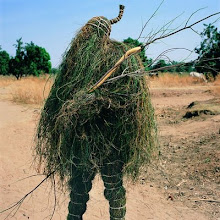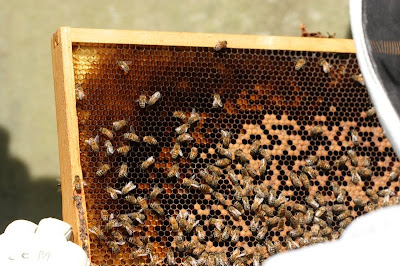Peter H. and Charley wait for Peter S. to get done with his phone call.
Tuesday we headed out to the beeyard to split the big superstar colony, hopefully preventing it from swarming this spring. The idea is that the beekeeper interrupts the bees' process of preparing for a swarm by dividing it in half and refocusing the bees on to building comb and building up their population. When a colony swarms, a totally natural springtime event that propagates the bee species, the end result is two colonies. A swarm is a beautiful sight to behold. It sounds like a freight train steaming through your yard and to see 20,000 golden buzzing insects in flight is breathtaking. The problem with swarming for the beekeeper is that you might not be there to catch the swarm and place it in a new hive box, plus the colony that stays behind will not produce much honey that year. For urban beekeepers, the bigger problem is freaking out your neighbors when 20,000 bees move into their attic or garage en masse. Managing the colonies to prevent swarming is the most responsible thing to do in an urban setting, it is beneficial to the beekeeper because you keep both colonies in your beeyard and perhaps beneficial to the bees...since they have expanded to two colonies without the effort of building up a swarm and do not have to look around for a new home.
My beekeeper friend, Peter S., came over to lend his experience and my co-beekeepers, Peter H. and Charley were also on hand for the excitement and to lend their brute strength (full hive boxes are heavy). I planned on standing back and taking lots of photos.
We started by opening up the hive and having a look at what they were up to on this fine spring morning. The hive was bubbling over with bees and they contentedly worked away as we lifted frame after frame and inspected them for a healthy brood pattern, the queen and any possible problems.
Peter H. and Charley look for the queen.
Peter H. hoping for his first glimpse of an egg.
We looked and looked but could not locate the queen. She was in there, because we saw many freshly laid eggs. This queen has a very healthy laying pattern. We saw a lot of capped and uncapped brood. I was able to see some eggs and larvae in various stages of development.
frame of uncapped larvae and eggs. The queen is probably on this frame or one nearby.
uncapped larvae
freshly laid eggs and a larger larvae
Since this hive was so healthy and active we decided it was a good candidate for a split. It was a little annoying that we could not find the queen and set her aside during the split, but even if we could not find her we knew she would end up in one or the other boxes. It is just better to keep her out of the way so nothing bad happens to her while moving all the frames and boxes around.
I had set up an empty hive box at the end of the beeyard a few days before just in case they swarmed and happened to find the box inviting. We took a frame with eggs and uncapped larvae and moved it into the middle of the empty box. Then we found another frame of mostly capped larvae and nurse bees and moved that one into the new box next. One either end of the box we placed a full frame of capped honey. Then just in from that a frame of pollen. I scrounged up 4 frames of empty drawn comb and we filled up the rest of the ten frame box with those so the queen would have someplace to lay her eggs.
The bees were getting a little irritable so we quickly closed the new hive up and went back to what was left of the original hive and filled in the empty spaces with new frames of wax foundation so they could get going on drawing out new comb. I had set a deep box on the hive the week before to give them space and maybe keep them from swarming until we could get out there and give them a proper inspection. That was not really a smart move because now the bees were putting capped honey in the deep frames which means we would have to extract a really heavy box of honey later on. But it was already started so we found some other half filled frames of honey and stuck them in the deep with a queen excluder separating the brood nest from the honey, hoping that they would fill those frames up in the next week or so and then we could extract them and use them in the brood chamber once they were empty of honey.
The split of the superstar hive went very smoothly. The two new hives seemed to be set up pretty well for spring. One of them contains an already laying queen and the other enough eggs and nurse bees so that they can create a new queen by feeding a few of the eggs royal jelly. Hopefully, if we keep up on them and give them all the space the queens need to lay eggs, we may have acted early enough to prevent any swarms this season. Of course, the bees do what they want, so they may decide to swarm later anyway.












Your bees are beautiful!!! Great photos, and a good description of how to split a hive. :) I can't wait to have my own hives to tend. I love bees so much - their hum, the honey and sunshine smell...*sigh*
ReplyDeletehttp://www.swamppixieherbal.blogspot.com